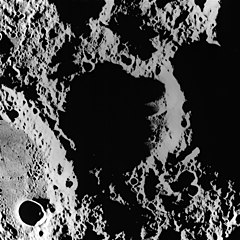
Lunar Orbiter 2 image | |
| Coordinates | 24°54′S 177°24′E / 24.9°S 177.4°E |
|---|---|
| Diameter | 76 km |
| Depth | Unknown |
| Colongitude | 177° at sunrise |
| Eponym | Jason J. Nassau |

Nassau is a lunar impact crater on the Moon's far side. It abuts against the northeastern rim of the figure-8-shaped crater Van de Graaff. To the southeast of Nassau lies the crater Leeuwenhoek, and to the east is Orlov.
Nassau has a somewhat eroded crater rim, with small craters lying across the edge along the eastern, northwestern and southwestern sides. Along the southwestern inner wall, where the crater joins Van de Graaff, a ridge of material extends northward part way into the interior floor. The bottom of the crater is nearly level, but is marked by several small craterlets. The most notable of these interior craters lies near the midpoint.
By convention these features are identified on lunar maps by placing the letter on the side of the crater midpoint that is closest to Nassau.
| Nassau | Latitude | Longitude | Diameter |
|---|---|---|---|
| D | 23.7° S | 179.2° W | 62 km |
| F | 24.7° S | 179.2° W | 112 km |
| Y | 22.5° S | 176.8° E | 38 km |
- Andersson, L. E.; Whitaker, E. A. (1982). NASA Catalogue of Lunar Nomenclature. NASA RP-1097.
- Blue, Jennifer (July 25, 2007). "Gazetteer of Planetary Nomenclature". USGS. Retrieved 2007-08-05.
- Bussey, B.; Spudis, P. (2004). The Clementine Atlas of the Moon. New York: Cambridge University Press. ISBN 978-0-521-81528-4.
- Cocks, Elijah E.; Cocks, Josiah C. (1995). Who's Who on the Moon: A Biographical Dictionary of Lunar Nomenclature. Tudor Publishers. ISBN 978-0-936389-27-1.
- McDowell, Jonathan (July 15, 2007). "Lunar Nomenclature". Jonathan's Space Report. Retrieved 2007-10-24.
- Menzel, D. H.; Minnaert, M.; Levin, B.; Dollfus, A.; Bell, B. (1971). "Report on Lunar Nomenclature by the Working Group of Commission 17 of the IAU". Space Science Reviews. 12 (2): 136–186. Bibcode: 1971SSRv...12..136M. doi: 10.1007/BF00171763. S2CID 122125855.
- Moore, Patrick (2001). On the Moon. Sterling Publishing Co. ISBN 978-0-304-35469-6.
- Price, Fred W. (1988). The Moon Observer's Handbook. Cambridge University Press. ISBN 978-0-521-33500-3.
- Rükl, Antonín (1990). Atlas of the Moon. Kalmbach Books. ISBN 978-0-913135-17-4.
- Webb, Rev. T. W. (1962). Celestial Objects for Common Telescopes (6th revised ed.). Dover. ISBN 978-0-486-20917-3.
- Whitaker, Ewen A. (1999). Mapping and Naming the Moon. Cambridge University Press. ISBN 978-0-521-62248-6.
- Wlasuk, Peter T. (2000). Observing the Moon. Springer. ISBN 978-1-85233-193-1.

Lunar Orbiter 2 image | |
| Coordinates | 24°54′S 177°24′E / 24.9°S 177.4°E |
|---|---|
| Diameter | 76 km |
| Depth | Unknown |
| Colongitude | 177° at sunrise |
| Eponym | Jason J. Nassau |

Nassau is a lunar impact crater on the Moon's far side. It abuts against the northeastern rim of the figure-8-shaped crater Van de Graaff. To the southeast of Nassau lies the crater Leeuwenhoek, and to the east is Orlov.
Nassau has a somewhat eroded crater rim, with small craters lying across the edge along the eastern, northwestern and southwestern sides. Along the southwestern inner wall, where the crater joins Van de Graaff, a ridge of material extends northward part way into the interior floor. The bottom of the crater is nearly level, but is marked by several small craterlets. The most notable of these interior craters lies near the midpoint.
By convention these features are identified on lunar maps by placing the letter on the side of the crater midpoint that is closest to Nassau.
| Nassau | Latitude | Longitude | Diameter |
|---|---|---|---|
| D | 23.7° S | 179.2° W | 62 km |
| F | 24.7° S | 179.2° W | 112 km |
| Y | 22.5° S | 176.8° E | 38 km |
- Andersson, L. E.; Whitaker, E. A. (1982). NASA Catalogue of Lunar Nomenclature. NASA RP-1097.
- Blue, Jennifer (July 25, 2007). "Gazetteer of Planetary Nomenclature". USGS. Retrieved 2007-08-05.
- Bussey, B.; Spudis, P. (2004). The Clementine Atlas of the Moon. New York: Cambridge University Press. ISBN 978-0-521-81528-4.
- Cocks, Elijah E.; Cocks, Josiah C. (1995). Who's Who on the Moon: A Biographical Dictionary of Lunar Nomenclature. Tudor Publishers. ISBN 978-0-936389-27-1.
- McDowell, Jonathan (July 15, 2007). "Lunar Nomenclature". Jonathan's Space Report. Retrieved 2007-10-24.
- Menzel, D. H.; Minnaert, M.; Levin, B.; Dollfus, A.; Bell, B. (1971). "Report on Lunar Nomenclature by the Working Group of Commission 17 of the IAU". Space Science Reviews. 12 (2): 136–186. Bibcode: 1971SSRv...12..136M. doi: 10.1007/BF00171763. S2CID 122125855.
- Moore, Patrick (2001). On the Moon. Sterling Publishing Co. ISBN 978-0-304-35469-6.
- Price, Fred W. (1988). The Moon Observer's Handbook. Cambridge University Press. ISBN 978-0-521-33500-3.
- Rükl, Antonín (1990). Atlas of the Moon. Kalmbach Books. ISBN 978-0-913135-17-4.
- Webb, Rev. T. W. (1962). Celestial Objects for Common Telescopes (6th revised ed.). Dover. ISBN 978-0-486-20917-3.
- Whitaker, Ewen A. (1999). Mapping and Naming the Moon. Cambridge University Press. ISBN 978-0-521-62248-6.
- Wlasuk, Peter T. (2000). Observing the Moon. Springer. ISBN 978-1-85233-193-1.